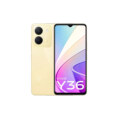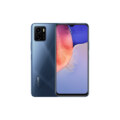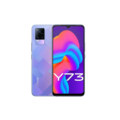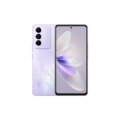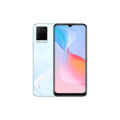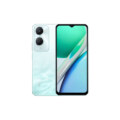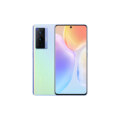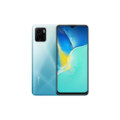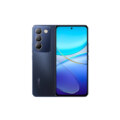Vivo Y33T
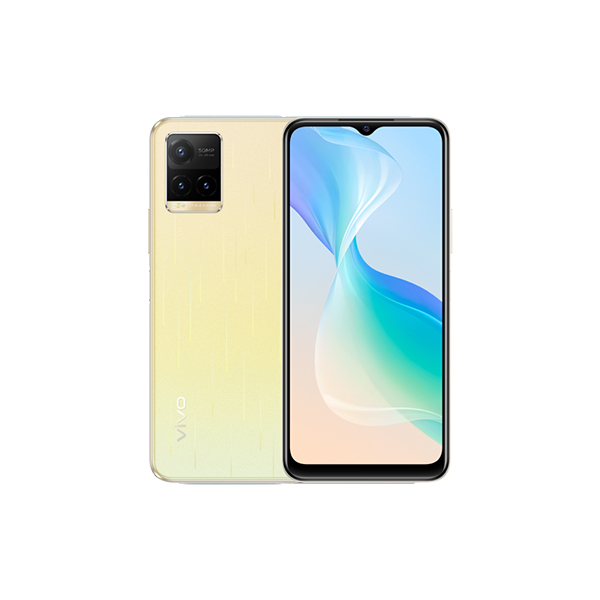

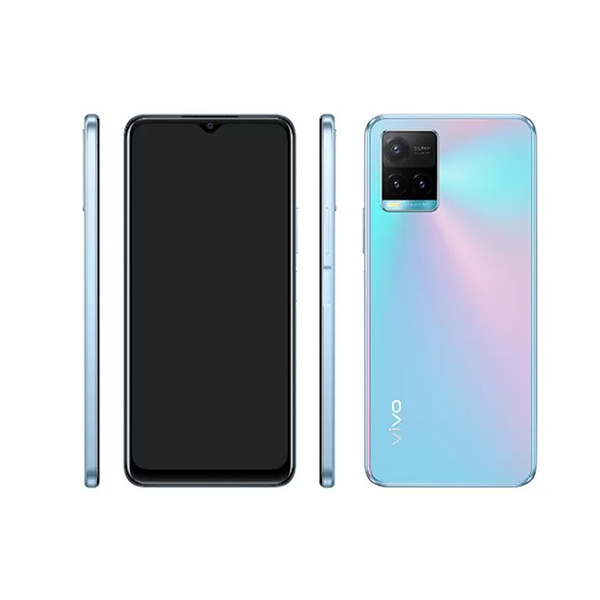
Specs
General
| Device Type | Vivo Phone |
| Announced | 11 January, 2022 |
| Released | 12 January, 2022 |
| Status | Available |
Design
| Dimensions | 164.3 x 76.1 x 8 mm |
| Weight | 182 g |
| Protection | Glass front, plastic frame, plastic back |
| Colors | Starry Gold |
Display
| Refresh Rate | 60 Hz |
| Display Type Display Technology => A number of display technologies and types used in mobile phones => TFT (Thin Film Transistor), IPS (In-Place Switching), OLED (Organic Light Emitting Diode), AMOLED (Active-Matrix Organic Light-Emitting Diode), Super AMOLED (an even advanced version of AMOLED), Resistive Touchscreen (Resistive touchscreens contain two layer of conductive material with a very small gap between them which acts as a resistance), Capacitive Touchsceen (Capacitive touchscreen technology consists of a layer of glass coated with a transparent conductor) | IPS LCD |
| Size | 6.58 inches |
| Resolution | 1080 x 2408 pixels |
| Display Colors Display Colors is refers to the number of different shades of colors that the screen is capable of displaying => 64K colors, 256K colors and 16 million colors, Obviously 16M is highest available range of colors and better than others. | 16M Colors |
| Pixel Density Pixel Density (PPI) is refers to the concentration of pixels on a particular display, measured in pixels per inch (ppi). Pixel density is calculated by dividing the diagonal pixel resolution of a display by its diagonal size, higher pixel density better display quality. | ~ 401 ppi |
| Touch Screen | Capacitive Touchscreen, Multitouch |
| Secondary Display | No |
Camera
| Front Camera | 16 MP, f/2.0, (wide) |
| Camera Setup | Triple |
| Main Camera Camera is able to capture photographs and usually videos, The most important characteristics of a camera are the resolution (measured in megapixels), lens focus type (fixed or automatic), higher megapixel cameras are known to capture higher quality photos, but not always a good measurement of the photos quality. |
50 MP, f/1.8, (wide), PDAF 2 MP, f/2.4, (macro) 2 MP, f/2.4, (depth) |
| Video | 1080p@30fps |
| Camera Features | Geo-tagging, Phase detection, Panorama, HDR |
| Flash Flash Light => There is commonly two types of flash lights are used in camera mobile phones, LED Flash (LED flash offers lower power consumption with drive circuitry that takes up very little room, LEDs can be strobed faster than any other light source), Xenon Flash (xenon flash produces an extremely intense full-spectrum white light for a very short duration) | LED flash |
Hardware
| Operating System OS => Every computer system run on a base software called Operating System (OS). Operating System controls all basic operations of the computer (such as smartphone, PDAs, tablet computers and other handheld devices). The Operating System allows the user to install and run third party applications (apps), apps are used to add new functionality to the device. | Android 11 |
| Chipset Chipset is a group of integrated circuits designed to perform one or a more dedicated functions, often with real time computing constraints, Popular smartphones are equipped with more advanced embedded chipsets that can do many different tasks depending on their programming. | Qualcomm SM6225 Snapdragon 680 4G |
| CPU CPU (Central Processing Unit) mostly known as processors, CPU processes instructions in order to carry out certain functions that make your device operate properly. Processors are often described as the brain of computers, smartphones and tablets, Smartphones and tablets rely on processors to carry out their every task, Processors are an incredibly important factor in selecting any type of computing device, including your smartphone. | Octa-core (4x2.4 GHz Kryo 265 Gold & 4x1.9 GHz Kryo 265 Silver) |
| Architecture | 64 bit |
| Fabrication | 6 nm |
| GPU GPU (Graphics Processing Unit) is a single-chip processor designed to rapidly manipulate and alter memory to accelerate the creation of images in a frame buffer intended for output to a display, This includes things such as lighting effects, object transformations, and 3D motion. | Adreno 610 |
| RAM (Memory) RAM (Random Access Memory) is a type of computer memory that can be accessed randomly, any byte of memory can be accessed without touching the preceding bytes that allows information to be stored and accessed quickly from random locations. RAM is the most common type of memory found in computer systems, smartphones, tablets and other electronic devices. | 8 GB |
| Internal Storage Internal Storage is a data storage space (flash memory) mostly used in smartphones, tablets and other electronic devices where operating system, apps, music, photos, videos, files and other user data Is stored. | 128GB Built-in |
| Card Slot Memory Card Slot is a special slot for inserting a memory card. Memory cards allow you to expand the phone's built-in memory, A memory card (sometimes called a flash memory card or a storage card) is a small storage medium used to store data such as text, pictures, audio, and video, for use on small, portable or remote computing devices such as mobile phones, mp3 players, digital cameras. | |
| Sensors Sensors are electronic components that detects and responds to some type of input from the physical environment. The specific input could be light, heat, motion, moisture, pressure and location, The output is generally a signal that is converted to use in computing systems, a location sensor, such as a GPS receiver is able to detect current location of your electronic device. | Accelerometer, Compass, FingerPrint (side-mounted), Proximity |
Network
| SIM TYPE SIM (Subscriber Identity Module) is a small card that contains mobile network subscriber's account information. This allows the phone using the card to attach to a mobile network. The SIM card is most commonly associated with GSM and UMTS mobile networks. Moving a SIM card from one phone to another allows a subscriber to switch mobile phones without having to contact their mobile network carrier. SIM cards can also be used by a phone to store limited amounts of data, such as phone numbers and text messages. | Nano SIM |
| SIM Technology | Dual Sim, Dual Standby (Nano-SIM) |
| 2G Network | GSM 850 / 900 / 1800 / 1900 |
| 3G Network | HSDPA 850 / 900 / 1700(AWS) / 1900 / 2100 |
| 4G Network | LTE band 1(2100), 3(1800), 7(2600), 8(900), 20(800) |
Multimedia
| FM Radio | |
| Stereo Speakers | NO |
| Loudspeaker | YES |
| Audio Jack | 3.5mm Audio Jack |
| Audio Features | 32-bit/192kHz Hi-Res audio |
Connectivity
| Wi-fi Wi-Fi is a popular wireless networking technology using radio waves to provide high-speed network connections that allows devices to communicate without cords or cables, Wi-Fi is increasingly becoming the preferred mode of internet connectivity all over the world. | Wi-Fi 802.11 a/b/g/n/ac, dual-band, Wi-Fi Direct |
| Bluetooth Bluetooth is a wireless communications technology for exchanging data between mobile phones, headsets, computers and other network devices over short distances without wires, Bluetooth technology was primarily designed to support simple wireless networking of personal consumer devices. | 5.0, A2DP, LE |
| GPS GPS The Global Positioning System is a satellite-based radio navigation system, GPS permits users to determine their position, velocity and the time 24 hours a day, in all weather, anywhere in the world, In order to locate your position, your device or GPS receiver must have a clear view of the sky. | GPS, GLONASS, GALILEO, BDS |
| USB | USB Type-C 2.0, OTG |
| EDGE EDGE (Enhanced Data GSM Environment) is a wireless network technology generally considered the next step in the 2G network offers data transfer rates up to four times faster than ordinary GSM networks, Generally, EDGE is used for the purpose of wireless data transfer, such as sharing pictures and videos or browsing the Internet via a mobile phone connection. | |
| GPRS GPRS (General Packet Radio Service) is a packet oriented mobile data service on the 2G and 3G cellular communication system's global system for mobile communications (GSM), Generally, GPRS is used for the purpose of wireless data transfer, such as sharing pictures and videos or browsing the Internet via a mobile phone connection. | |
| Speed | 3G (HSPA 42.2/5.76 Mbps), 4G LTE-A |
| Wi-fi Hotspot | |
| NFC NFC (Near field communication) is a set of standards for smartphones and similar devices to establish peer-to-peer radio communications with each other by touching them together or bringing them into proximity, usually no more than a few inches. |
Features
| Messaging | SMS(threaded view), MMS, Email, Push Mail, IM |
| Web Browser Web Browser => a web browser is a software application used to locate, retrieve and display content on the World Wide Web, including Web pages, images, video and other files, The primary function of a web browser is to render HTML, the code used to design or markup webpages. | HTML5 |
| Games | Built-in + Downloadable |
| Torch |
Battery
| Battery Type Battery Type => Cell phones run on various kinds of batteries depending on the manufacturer, phone size or shape and features. There are basically four types of cell phone batteries => Lithium Polymer, Lithium Ion, Nickel Metal Hydride and Nickel Cadmium. | Li-Ion (Lithium Ion) |
| Capacity Battery Capacity is a measure (typically in Amp-hr) of the charge stored by the battery, and is determined by the mass of active material contained in the battery. The battery capacity represents the maximum amount of energy that can be extracted from the battery under certain conditions. | 5000 mAh |
| Placement | Non-removable |
| Wireless Charging Wireless Charging (Inductive Charging) uses an electromagnetic field to transfer energy between two objects. This is usually done with a charging station. Energy is sent through an inductive coupling to an electrical device, which can then use that energy to charge batteries or run the device. | No |
| Extra |
18W wired 2.5W reverse wired |
Introduction:
The Vivo Y33T is a mid-range smartphone launched to cater to users looking for a balance of performance, design, and battery life without a premium price tag. The Y33T features Qualcomm’s Snapdragon 680 chipset, a large 5000mAh battery, and a 50MP main camera, positioning itself as a solid option for users who prioritize battery life and photography. This review provides an in-depth look at the Vivo Y33T, covering its design, display, performance, camera system, battery life, software, and more, along with a summary of its pros and cons.
Specifications at a Glance:
- Display: 6.58-inch IPS LCD (2408 x 1080 pixels, 401 ppi)
- Processor: Qualcomm Snapdragon 680
- RAM: 8 GB (with 4 GB extended RAM feature)
- Storage Options: 128 GB (expandable via microSD up to 1TB)
- Rear Cameras: Triple camera setup (50 MP wide f/1.8, 2 MP macro, 2 MP depth)
- Front Camera: 16 MP (f/2.0)
- Battery: 5000mAh with 18W fast charging
- Operating System: FunTouch OS 12 based on Android 11
- Audio: 3.5mm headphone jack, single speaker
- Dimensions: 164.3 x 76.1 x 8.0 mm
- Weight: 182 grams
Design and Build Quality:
- Aesthetics: The Vivo Y33T sports a sleek design with a glossy plastic back that mimics glass, giving it a premium feel despite its affordable price point. The camera module is placed in a rectangular housing at the back, while the front hosts a waterdrop-style notch for the front camera.
- Color Options: It is available in two striking colors—Mirror Black and Midday Dream—that offer a premium look.
- Durability: The plastic back, while shiny, is prone to fingerprints and minor scratches. It lacks any official water or dust resistance, so users will need to be cautious with spills or exposure to moisture.
- Ergonomics: With a weight of 182 grams and a slim profile of 8mm, the Y33T feels comfortable to hold and operate with one hand. The power button doubles as a side-mounted fingerprint sensor, providing quick and secure access.
Overall, the Vivo Y33T has a stylish and modern design for a budget phone, though the plastic build may not feel as premium as higher-end models.
Display:
- Specifications:
- Size: 6.58 inches
- Resolution: 2408 x 1080 pixels (FHD+)
- Panel Type: IPS LCD
- Refresh Rate: 90Hz
- Performance: The 6.58-inch IPS LCD display offers sharp visuals and decent color reproduction for its price range. While it doesn’t match the contrast and vibrancy of AMOLED displays, it performs well for watching videos, browsing, and light gaming. The FHD+ resolution ensures that text and images are crisp, making it suitable for everyday use.
- Brightness: It delivers a peak brightness of 550 nits, which is adequate for indoor use but might struggle under direct sunlight.
- Refresh Rate: The 90Hz refresh rate is a welcome addition, providing smoother scrolling and animation compared to traditional 60Hz displays, enhancing the overall user experience.
In summary, the Vivo Y33T’s display is a strong point for its class, offering a good balance between sharpness, smoothness, and color accuracy.
Performance:
- Hardware:
- Processor: Qualcomm Snapdragon 680
- RAM: 8 GB (with 4 GB virtual RAM support)
- Storage: 128 GB (expandable via microSD up to 1TB)
- Performance Evaluation: The Snapdragon 680 chipset is designed for efficiency rather than raw power. It handles everyday tasks such as browsing, messaging, and light gaming without any hiccups. The 8 GB of RAM, coupled with the extended RAM feature, ensures that multitasking is smooth, allowing users to switch between apps with minimal lag.
- Gaming: The Y33T can handle casual games like Subway Surfers and Candy Crush smoothly, but more graphic-intensive games like PUBG and Call of Duty: Mobile may require reduced settings for an optimal experience.
In conclusion, the Vivo Y33T offers reliable performance for most daily tasks, though it’s not built for heavy gaming or demanding applications.
Camera:
The Vivo Y33T’s camera setup is one of its standout features in this price range.
- Rear Cameras:
- Primary Lens: 50 MP wide lens (f/1.8) with PDAF
- Macro Lens: 2 MP (f/2.4)
- Depth Sensor: 2 MP (f/2.4)
- Front Camera: 16 MP (f/2.0)
- Camera Performance:
- Daylight Photography: The 50 MP main camera performs well in good lighting conditions, capturing sharp and detailed images with accurate colors. The wide aperture helps in producing clear photos even in slightly dim environments.
- Low-Light Photography: The phone struggles in low-light conditions. The lack of OIS (Optical Image Stabilization) means that low-light shots are prone to noise and lack detail.
- Macro and Depth Lenses: The 2 MP macro lens allows for close-up shots, but the image quality is mediocre at best. The depth sensor helps with portrait shots, adding a decent bokeh effect.
- Front Camera: The 16 MP front camera captures decent selfies in well-lit environments. Vivo’s AI beautification tends to over-smooth the skin, but it can be turned off for a more natural look.
In summary, the Vivo Y33T’s camera setup offers solid daylight performance, but low-light performance could be better, and the macro lens feels more like a filler feature.
Battery Life:
- Specifications:
- Battery Capacity: 5000mAh
- Charging: 18W fast charging
- Performance: The 5000mAh battery is a major selling point of the Vivo Y33T, offering up to two days of moderate use on a single charge. Even with heavy usage, the phone comfortably lasts a full day, making it ideal for users who need long battery life.
- Charging Speed: With the included 18W charger, the Y33T takes about 1.5 to 2 hours to fully charge, which is average for its class.
In conclusion, the Vivo Y33T excels in battery life, ensuring that users can go through their day without constantly worrying about recharging.
Software:
- Operating System: FunTouch OS 12, based on Android 11, runs on the Vivo Y33T. FunTouch OS offers a clean and responsive user interface, but it comes preloaded with some bloatware, which might be off-putting to some users.
- Features:
- Customization: FunTouch OS allows for a high degree of customization, from themes to app icons.
- Extended RAM: The 4 GB of virtual RAM enhances multitasking performance.
- Game Mode: For gaming enthusiasts, Vivo’s Game Mode optimizes performance for a smoother gaming experience.
In summary, the FunTouch OS offers a clean, responsive user experience, though some users may find the pre-installed apps excessive.
Pros & Cons:
Pros:
- Strong Battery Life: The 5000mAh battery easily lasts through a full day of usage.
- Large 90Hz Display: The 6.58-inch FHD+ display with a 90Hz refresh rate offers smooth visuals for its price range.
- Decent Main Camera: The 50 MP main camera performs well in daylight conditions.
- Expandable Storage: Supports microSD cards up to 1TB.
- Sleek Design: The phone looks premium despite its plastic build.
Cons:
- Average Low-Light Camera Performance: The lack of OIS impacts low-light photography.
- Slow Charging: While 18W fast charging is included, it’s slower compared to competitors.
- Bloatware: The FunTouch OS comes with unnecessary pre-installed apps.
- Plastic Build: The glossy plastic back is prone to scratches and fingerprints.
- No 5G: In an increasingly 5G-ready market, the absence of 5G might be a dealbreaker for some.
Conclusion:
The Vivo Y33T is a solid mid-range device that stands out for its long-lasting battery, smooth 90Hz display, and decent camera performance. It’s a well-rounded option for users looking for an affordable smartphone that can handle everyday tasks and provide good battery life, though it falls short in low-light photography and lacks 5G support.
Review
Disclaimer Note
All prices in Pakistan is updated daily from the price list provided by local shops and dealers but we can not guarantee that the information / price on this page is 100% correct (Human error is possible), always visit your local shop for exact cell phone cost & rate.

